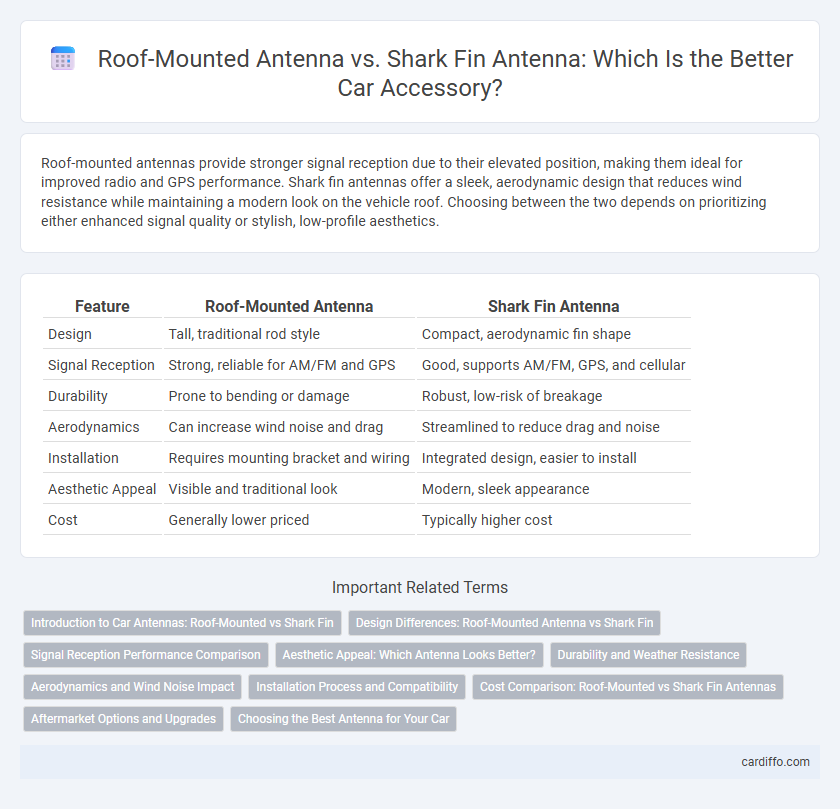Roof-mounted antennas provide stronger signal reception due to their elevated position, making them ideal for improved radio and GPS performance. Shark fin antennas offer a sleek, aerodynamic design that reduces wind resistance while maintaining a modern look on the vehicle roof. Choosing between the two depends on prioritizing either enhanced signal quality or stylish, low-profile aesthetics.
Table of Comparison
| Feature | Roof-Mounted Antenna | Shark Fin Antenna |
|---|---|---|
| Design | Tall, traditional rod style | Compact, aerodynamic fin shape |
| Signal Reception | Strong, reliable for AM/FM and GPS | Good, supports AM/FM, GPS, and cellular |
| Durability | Prone to bending or damage | Robust, low-risk of breakage |
| Aerodynamics | Can increase wind noise and drag | Streamlined to reduce drag and noise |
| Installation | Requires mounting bracket and wiring | Integrated design, easier to install |
| Aesthetic Appeal | Visible and traditional look | Modern, sleek appearance |
| Cost | Generally lower priced | Typically higher cost |
Introduction to Car Antennas: Roof-Mounted vs Shark Fin
Roof-mounted antennas traditionally offer superior signal reception due to their elevated positioning, making them ideal for areas with weak signals. Shark fin antennas, favored for their sleek, aerodynamic design, combine multiple functions such as GPS, radio, and cellular in a compact form, enhancing vehicle aesthetics without compromising performance. Choosing between these antenna types depends on the balance of appearance, signal strength, and multifunctionality required by the vehicle owner.
Design Differences: Roof-Mounted Antenna vs Shark Fin
Roof-mounted antennas typically feature a long, protruding design that maximizes signal reception but may compromise vehicle aerodynamics. Shark fin antennas have a compact, streamlined shape that enhances vehicle aesthetics and reduces wind noise while maintaining adequate signal quality. The choice between these antenna types reflects a balance between functional performance and modern design preferences.
Signal Reception Performance Comparison
Roof-mounted antennas typically offer superior signal reception due to their elevated position, which allows for less obstruction and better line-of-sight to broadcast towers. Shark fin antennas, while more aerodynamic and stylish, often incorporate smaller, multifunctional components that may slightly reduce their reception range and sensitivity. Signal quality can also be influenced by the specific frequency bands supported, with roof-mounted antennas generally performing better on traditional AM/FM bands.
Aesthetic Appeal: Which Antenna Looks Better?
Roof-mounted antennas offer a classic and prominent look that appeals to those valuing traditional automotive design, often seen on older or utilitarian vehicles. Shark fin antennas provide a sleek, modern aesthetic that integrates smoothly with the car's contour, enhancing the vehicle's overall streamlined appearance. The choice between the two depends on whether the owner prefers a vintage or contemporary style, with the shark fin antenna increasingly favored for its minimalistic and aerodynamic design.
Durability and Weather Resistance
Roof-mounted antennas typically offer robust durability due to their straightforward design and heavy-duty materials, making them highly resistant to harsh weather conditions such as heavy rain, snow, and strong winds. Shark fin antennas incorporate aerodynamic shapes and waterproof seals that enhance weather resistance while reducing wind noise and drag, though they may be slightly more vulnerable to impact damage compared to traditional roof-mounted models. Both antenna types use corrosion-resistant coatings and UV-stabilized plastics to prolong lifespan in various environmental exposures.
Aerodynamics and Wind Noise Impact
Roof-mounted antennas traditionally protrude and create more aerodynamic drag, resulting in increased wind noise at high speeds. Shark fin antennas feature a streamlined design that minimizes air resistance, significantly reducing wind noise and improving fuel efficiency. Choosing a shark fin antenna enhances vehicle aerodynamics while maintaining effective signal reception.
Installation Process and Compatibility
Roof-mounted antennas require drilling a hole in the vehicle's roof for installation, making the process more invasive and potentially affecting the car's warranty or seals. Shark fin antennas offer a streamlined installation, typically attaching with adhesive pads or simple mounts without the need for roof modifications, enhancing compatibility with modern vehicles. Both antenna types are compatible with most car makes, but shark fin antennas are favored for their ease of installation and integration with factory wiring harnesses.
Cost Comparison: Roof-Mounted vs Shark Fin Antennas
Roof-mounted antennas typically cost between $20 and $50, making them a budget-friendly option for vehicle owners seeking essential functionality. Shark fin antennas, with prices ranging from $50 to $150, offer a more modern design and enhanced aerodynamics but come at a higher cost. Installation expenses also vary, where roof-mounted models require simpler mounting, whereas shark fin antennas often need professional installation, impacting overall expense.
Aftermarket Options and Upgrades
Roof-mounted antennas offer robust signal reception and straightforward aftermarket replacements compatible with a wide range of vehicle models, making them ideal for users prioritizing performance and ease of upgrade. Shark fin antennas provide a sleek, aerodynamic design favored in modern vehicle aesthetics and often come with integrated features such as GPS and cellular connectivity, appealing to buyers seeking multifunctional aftermarket enhancements. Aftermarket upgrade options for shark fin antennas typically include improved signal modules and customizable finishes, while roof-mounted antennas emphasize durable, high-gain replacements for enhanced radio and satellite reception.
Choosing the Best Antenna for Your Car
Roof-mounted antennas provide superior signal reception due to their elevated position, making them ideal for rural or low-signal areas. Shark fin antennas offer a sleek, aerodynamic design that reduces wind noise and enhances vehicle aesthetics while maintaining reliable connectivity. Choosing the best antenna depends on balancing signal needs with design preferences and vehicle type.
Roof-Mounted Antenna vs Shark Fin Antenna Infographic

 cardiffo.com
cardiffo.com